Separation of Biological Entities from Human Blood by Using Magnetic Nanocomposites Obtained from Zeolite Precursors
Abstract
1. Introduction
2. Results and Discussion
2.1. Physico-Chemical Characterization of the Magnetic Adsorbents
2.2. Magnetic Characterization
2.3. Separation of Biological Entities
3. Material and Methods
3.1. Chemicals and Materials Synthesis
3.2. Characterization Methods
3.3. Separation of Biological Entities
- DNA denaturation, during which the two filaments are separated (at temperature > 90 °C);
- Duplication of the separated DNA filaments by proper nucleotides and action of the polymerase enzyme (at about 50–60 °C);
- Extension of the DNA chain by enzyme polymerase (at about 70–75 °C).
4. Conclusions
Author Contributions
Funding
Acknowledgments
Conflicts of Interest
References
- Berensmeier, S. Magnetic Particles for the Separation and Purification of Nucleic Acids. Appl. Microbiol. Biotechnol. 2006, 73, 495–504. [Google Scholar] [CrossRef] [PubMed]
- Volgenstein, B.; Gillespie, D. Preparative and Analytical Purification of DNA from Agarose. Proc. Natl. Acad. Sci. USA 1979, 76, 615–619. [Google Scholar]
- Boom, R.; Sol, C.J.; Salimans, M.M.; Jansen, C.L.; Wertheim-van Dillen, P.M.; van der Noordaa, J. Rapid and simple method for purification of nucleic acids. J. Clin. Microbiol. 1990, 28, 495–503. [Google Scholar] [CrossRef] [PubMed]
- Boom, R.; Sol, C.J.; Beld, M.; Weel, J.; Goudsmit, J.; Wertheim-van Dillen, P.M.P.M. Wertheim-van Dillen, P.M. Improved Silica-Guanidinium Thiocyanate DNA Isolation Procedure Based on Selective Binding of Bovine Alpha-Casein to Silica Particles. J. Clin. Microbiol 1999, 37, 615–619. [Google Scholar] [CrossRef] [PubMed]
- Melzak, K.A.; Sherwood, C.S.; Turner, R.F.B.; Haynes, C.A. Driving Forces for DNA Adsorption to Silica in Perchlorate Solution. J. Colloid Interface Sci. 1996, 181, 635–644. [Google Scholar] [CrossRef]
- Tian, H.; Huhmer, A.F.R.; Landers, J.P. Evaluation of Silica Resins for Direct and Efficient Extraction of DNA from Complex Biological Matrices in a Miniaturized Format. Anal. Biochem. 2000, 283, 175–191. [Google Scholar] [CrossRef]
- Breadmore, M.C.; Wolfe, K.A.; Arcibal, I.G.; Leung, W.K.; Dickson, D.; Giordano, B.C.; Power, M.E.; Ferrance, J.P.; Feldman, S.H.; Norris, P.M.; et al. Microchip-Based purification of DNA from biological samples. Anal. Chem. 2003, 75, 1880. [Google Scholar] [CrossRef]
- Ferreira, G.N.M.; Cabral, J.M.S.; Prezeres, D.M.F. Studies on the Batch Adsorption of Plasmid DNA onto Anion Exchange Chromatographic Support. Biotechnol. Prog. 2000, 16, 416–424. [Google Scholar] [CrossRef]
- Endres, N.H.; Johnson, J.A.; Ross, C.A.; Welp, J.K.; Etzel, M.R. Evaluation of an Ion Exchange Membrane for the Purification of a Plasmid DNA. Biotechnol. Appl. Biochem. 2003, 37, 259–266. [Google Scholar] [CrossRef]
- Teeters, M.A.; Conrardy, S.E.; Thomas, B.L.; Root, T.W.; Lightfoot, E.N. Adsorptive Membrane Chromatography for Purification of Plasmid DNA. J. Chromatogr. A 2003, 989, 165–173. [Google Scholar] [CrossRef]
- Ma, C.; Li, C.; He, N.; Wang, F.; Ma, N.; Zhang, L.; Lu, Z.; Ali, Z.; Xi, Z.; Li, X.; et al. Preparation and Characterization of Monodisperse Core-Shell Fe3O4@SiO2 Microspheres and its Application for Magnetic Separation of Nucleic Acids from E. coli BL21. J. Biomed. Nanotechnol. 2012, 8, 1000–1005. [Google Scholar] [CrossRef] [PubMed]
- Bruce, I.J.; Taylor, J.; Todd, M.; Davies, M.J.; Borioni, E.; Sangregorio, C.; Sen, T. Synthesis, Characterization and Application of Silica-Magnetite Nanocomposite. J. Magn. Magn. Mater. 2004, 284, 145–160. [Google Scholar] [CrossRef]
- He, Q.; Shao, L.; Yu, J.; Ji, S.; Wang, H.; Mao, Y.; Chen, J. Urinary Proteome Analysis by Matrix-Assisted Laser Desorption/Ionization Time-of-Flight Mass Spectrometry with Magnetic Beads for Identifying the Pathologic Presentation of Clinical Early IgA Nephropathy. J. Biomed. Nanotechnol 2012, 8, 133–139. [Google Scholar] [CrossRef] [PubMed]
- Cauda, V.; Szeifert, J.M.; Merk, K.; Fattakhova-Rohlfing, D.; Bein, T. All-Inorganic Core-Shell Silica-Titania Mesoporous Colloidal Nanoparticles Showing Orthogonal Functionality. J. Mater. Chem. 2001, 21, 13817–13824. [Google Scholar] [CrossRef]
- Gao, J.; Gu, H.; Xu, B. Multifunctional Magnetic Nanoparticles: Design, Synthesis and Biomedical Applications. Acc. Chem. Res. 2009, 42, 1097–1107. [Google Scholar] [CrossRef]
- Singh, R.K.; Kim, T.H.; Patel, K.D.; Knowles, J.C.; Kim, H.W. Biocompatible Magnetite Nanoparticles with Varying Silica Coating Layer for Use in Biomedicine: Physicochemical and Magnetic Properties, and Cellular Compatibility. J. Biomed. Mater. Res. A 2012, 100, 1734–1742. [Google Scholar] [CrossRef]
- Souza, D.M.; Andrade, A.L.; Fabris, J.D.; Valerio, P.; Goes, A.M.; Leite, M.F.; Domingues, R.Z. Synthesis and in Vitro Evaluation of Toxicity of Silica-Coated Magnetite Particles. J. Non-Cryst. Solids. 2008, 354, 4894–4897. [Google Scholar] [CrossRef]
- Kang, K.; Choi, J.; Nam, J.H.; Lee, S.C.; Kim, K.J.; Lee, S.W.; Chang, J.H. Preparation and Characterization of Chemically Functionalized Silica-Coated Magnetic Nanoparticles as a DNA Separator. J. Phys. Chem. B 2009, 113, 536–543. [Google Scholar] [CrossRef]
- Smerkova, K.; Dostalova, S.; Vaculonicova, M.; Kynicky, J.; Trnkova, L.; Kralik, M.; Adam, J.; Hubalek, V.; Provaznik, I.; Kizek, R. Investigation of Interaction between Magnetic Silica Particles and Lambda Phage DNA Fragment. J. Pharm. Biomed. Anal. 2013, 86, 65–72. [Google Scholar] [CrossRef]
- Horak, D.; Babic, M.; Mackova, H.; Benes, M.J. Preparation and Properties of Magnetic Nano- and Microsized Particles for Biological and Environmental Separations. J. Sep. Sci. 2007, 30, 1751–1772. [Google Scholar] [CrossRef]
- Lu, A.H.; Salabas, E.L.; Schut, F. Magnetic Nanoparticles: Synthesis, Protection, Functionalisation, and Application. Angew. Chem. Int. Ed. 2007, 46, 1222–1244. [Google Scholar] [CrossRef] [PubMed]
- Hsing, I.M.; Xu, Y.; Zhao, W. Micro- and Nano- Magnetic Particles for Applications in Biosensing. Electroanal. 2007, 19, 755–768. [Google Scholar] [CrossRef]
- Tartaj, P.; del Puerto Morales, M.; Veintemillas-Verdaguer, S.; Gonzalez-Carreno, T.; Serna, C.J. The Preparation of Magnetic Nanoparticles for Applications in Biomedicine. J. Phys. D: Appl. Phys. 2003, 36, R182–R197. [Google Scholar] [CrossRef]
- Shafia, E.; Esposito, S.; Manzoli, M.; Chiesa, M.; Tiberto, P.; Barrera, G.; Menard, G.; Allia, P.F.; Freyria, S.; Garrone, E.; et al. Al/Fe isomorphic substitution versus Fe2O3 clusters formation in Fe-doped aluminosilicate nanotubes (imogolite). J. Nanopart. Res. 2015, 17, 336. [Google Scholar] [CrossRef]
- Esposito, S.; Marocco, A.; Bonelli, B.; Pansini, M. Produzione di Materiali Compositi Metallo-Ceramici Nano Strutturati da Precursori Zeolitici. Available online: https://iris.unicas.it/handle/11580/55654?mode=full.565 (accessed on 11 April 2020).
- Esposito, S.; Marocco, A.; Bonelli, B.; Pansini, M. Production of Magnetic Metal Nanoparticles Embedded in a Silica-Alumina Matrix. WO Patent 2015/145230 A1, 1 October 2015. [Google Scholar]
- Breck, D.W. Zeolite Molecular Sieves: Structure, Chemistry and Uses; Wiley: New York, NY, USA, 1974. [Google Scholar]
- Dwyer, F.G. An Introduction to Molecular Sieves Zeolites; J. Wiley and Sons: Chichester, UK, 1988. [Google Scholar]
- Ronchetti, S.; Turcato, E.A.; Delmastro, A.; Esposito, S.; Ferone, C.; Pansini, M.; Onida, B.; Mazza, D. Study of the thermal transformations of Co- and Fe-exchanged zeolites A and X by“in situ” XRD under reducing atmosphere. Mater. Res. Bull. 2010, 45, 744–750. [Google Scholar] [CrossRef]
- Marocco, A.; Dell’Agli, G.; Esposito, S.; Pansini, M. Metal-ceramic composite materials from zeolite precursor. Solid State Sci. 2012, 14, 394–400. [Google Scholar] [CrossRef]
- Esposito, S.; Dell’Agli, G.; Marocco, A.; Bonelli, B.; Allia, P.; Tiberto, P.; Barrera, G.; Manzoli, M.; Arletti, R.; Pansini, M. Magnetic metal-ceramic nanocomposites obtained from cation-exchanged zeolite by heat treatment in reducing atmosphere. Microporous Mesoporous Mater. 2018, 268, 131–143. [Google Scholar] [CrossRef]
- Barrera, G.; Tiberto, P.; Esposito, S.; Marocco, A.; Bonelli, B.; Pansini, M.; Manzoli, M.; Allia, P. Magnetic clustering of Ni2+ ions in metal-ceramic nanocomposites obtained from Ni-exchanged zeolite precursors. Ceram. Int. 2018, 44, 17240–17250. [Google Scholar] [CrossRef]
- Barrera, G.; Tiberto, P.; Allia, P.; Bonelli, B.; Esposito, S.; Marocco, A.; Pansini, M.; Leterrier, Y. Magnetic properties of nanocomposites. Appl. Sci. 2019, 9, 212. [Google Scholar] [CrossRef]
- Barrera, G.; Allia, P.; Bonelli, B.; Esposito, S.; Freyria, F.S.; Pansini, M.; Marocco, A.; Confalonieri, G.; Arletti, R.; Tiberto, P. Magnetic behavior of Ni nanoparticles and Ni2+ ions in weakly loaded zeolitic structures. J. Alloy. Compd. 2020, 817. [Google Scholar] [CrossRef]
- Pansini, M.; Sannino, F.; Marocco, A.; Allia, P.; Tiberto, P.; Barrera, G.; Polisi, M.; Battista, E.; Netti, P.A.; Esposito, S. Novel process to prepare magnetic metal-ceramic nanocomposites from zeolite precursor and their use as adsorbent of agrochemicals from water. J. Environ. Chem. Eng. 2018, 6, 527–538. [Google Scholar] [CrossRef]
- Marocco, A.; Dell’Agli, G.; Sannino, F.; Esposito, S.; Bonelli, B.; Allia, P.; Tiberto, P.; Barrera, G.; Pansini, M. Removal of Agrochemicals from Waters by Adsorption: A Critical Comparison among Humic-Like Substances, Zeolites, Porous Oxides, and Magnetic Nanocomposites. Processes 2020, 8, 141. [Google Scholar] [CrossRef]
- Freyria, F.S.; Marocco, A.; Esposito, S.; Bonelli, B.; Barrera, G.; Tiberto, P.; Allia, P.; Oudayer, P.; Confalonieri, G.; Arletti, R.; et al. Simulated Moon agglutinates obtained from zeolite precursor by means of a low-cost and scalable synthesis method. ACS Earth Space Chem. 2019, 3, 1884–1895. [Google Scholar] [CrossRef]
- Pansini, M.; Dell’Agli, G.; Marocco, A.; Netti, P.A.; Battista, E.; Lettera, V.; Vergara, P.; Allia, P.; Bonelli, B.; Tiberto, P.; et al. Preparation and Characterization of Magnetic and Porous Metal-Ceramic Nanocomposites from a Zeolite Precursor and Their Application for DNA Separation. J. Biomed. Nanotechnol. 2017, 13, 337–348. [Google Scholar] [CrossRef]
- Paulsen, J.; Mehl, A.; Askim, Å.; Solligård, E.; Åsvold, B.O.; Damås, J.K. Epidemiology and outcome of Staphylococcus aureus bloodstream infection and sepsis in a Norwegian county 1996–2011: An observational study. BMC Infect. Dis. 2015, 15, 116. [Google Scholar] [CrossRef]
- Laupland, K.B.; Valiquette, L. The changing culture of the microbiology laboratory. Can. J. Infect. Dis. Med. Microbiol. 2013, 24, 125–128. [Google Scholar] [CrossRef]
- Ferone, C.; Liguori, B.; Marocco, A.; Anaclerio, S.; Pansini, M.; Colella, C. Monoclinic (Ba, Sr)-celsian by thermal treatment of (Ba, Sr)-exchanged zeolite A. Microporous Mesoporous Mater. 2010, 134, 65–71. [Google Scholar] [CrossRef]
- Leong, S.S.; Yeap, S.P.; Lim, J.K. Working principle and application of magnetic separation for biomedical diagnostic at high- and low-field gradients. Interface Focus 2016, 6, 17. [Google Scholar] [CrossRef]
- Lim, J.K.; Yeap, S.P.; Low, S.C. Challenges associated to magnetic separation of nanomaterials at low field gradient. Separ. Purif. Technol. 2014, 123, 171–174. [Google Scholar] [CrossRef]
- Andreu, J.S.; Barbero, P.; Camacho, J.; Faraudo, J. Simulation of Magnetophoretic Separation Processes in Dispersions of Superparamagnetic Nanoparticles in the Noncooperative Regime. J. Nanomater. 2012, 678581. [Google Scholar] [CrossRef]
- Li, X.; Zhang, J.; Gu, H. Adsorption and desorption behaviors of DNA with magnetic mesoporous nanoparticles. Langmuir 2011, 27, 6099–6106. [Google Scholar] [CrossRef] [PubMed]
- Shi, B.; Shin, Y.K.; Hassanali, A.A.; Singer, S.J. DNA binding to the silica surface. J. Phys. Chem. B 2015, 119, 11030–11040. [Google Scholar] [CrossRef] [PubMed]
- Baerlocher, C.; Meier, W.M.; Olson, D.H. Atlas of Zeolite Framework Types; Elsevier: Amsterdam, The Netherlands, 2001; pp. 132–133. [Google Scholar]
- Esposito, S.; Marocco, A.; Dell’Agli, G.; De Gennaro, B.; Pansini, M. Relationships between the Water Content of Zeolites and Their Cation Population. Microporous Mesoporous Mater. 2015, 202, 36–43. [Google Scholar] [CrossRef]
- Marocco, A.; Dell’Agli, G.; Spiridigliozzi, L.; Esposito, S.; Pansini, M. The Multifarious Aspects of the Thermal Conversion of Ba-Exchanged Zeolite A to Monoclinic Celsian. Microporous Mesoporous Mater. 2018, 256, 235–250. [Google Scholar] [CrossRef]
- Weidenthaler, C.; Zibrowius, B.; Schimanke, J.; Mao, Y.; Mienert, B.; Bill, E.; Schmidt, W. Oxidation Behavior of Ferrous Cations during Ion Exchange into Zeolites under Atmospheric Conditions. Microporous Mesoporous Mater. 2005, 84, 302–317. [Google Scholar] [CrossRef]
- Marocco, A.; Liguori, B.; Dell’Agli, G.; Pansini, M. Sintering Behaviour of Celsian Based Ceramics Obtained from the Thermal Conversion of (Ba, Sr)-Exchanged Zeolite, A.J. Eur. Ceram. Soc. 2011, 31, 1965–1973. [Google Scholar] [CrossRef]
- Clayden, N.; Esposito, E.; Ferone, C.; Pansini, M. 27Al and 28Si NMR study of the thermal transformation of Ba-exchanged zeolite A into monoclinic celsian. J. Mater. Chem. 2003, 13, 1681–1685. [Google Scholar] [CrossRef]
- Dell’Agli, G.; Ferone, C.; Mascolo, G.; Pansini, M. Crystallization of monoclinic zirconia from metastable phase. Solid State Ion. 2000, 127, 223–230. [Google Scholar] [CrossRef]
- Colantuono, A.; Dal Vecchio, S.; Mascolo, G.; Pansini, M. Thermal shrinkage of various cation forms of zeolite A. Thermochimica Acta 1997, 296, 1406–1414. [Google Scholar] [CrossRef]
- Rotoli, B.M.; Guidi, P.; Bonelli, B.; Bernardeschi, M.; Bianchi, M.G.; Esposito, S.; Frenzilli, G.; Lucchesi, P.; Nigro, M.; Scarcelli, V.; et al. An Aluminosilicate Nanotube Endowed with Low Cytotoxicity and Genotoxicity. Chem. Res. Toxicol. 2014, 27, 1142–1154. [Google Scholar] [CrossRef]
- Patrinos, G.; Ansorge, W. Molecular diagnotics; Academic Press: Cambridge, MA, USA, 2009. [Google Scholar]
- Soejima, T.; Xiao, J.Z.; Abe, F. A novel mechanism for direct real-time polymerase chain reaction that does not require DNA isolation from prokaryotic cells. Sci. Rep. 2016, 6. [Google Scholar] [CrossRef] [PubMed]
Sample Availability: Samples of the compounds are available from the authors. |
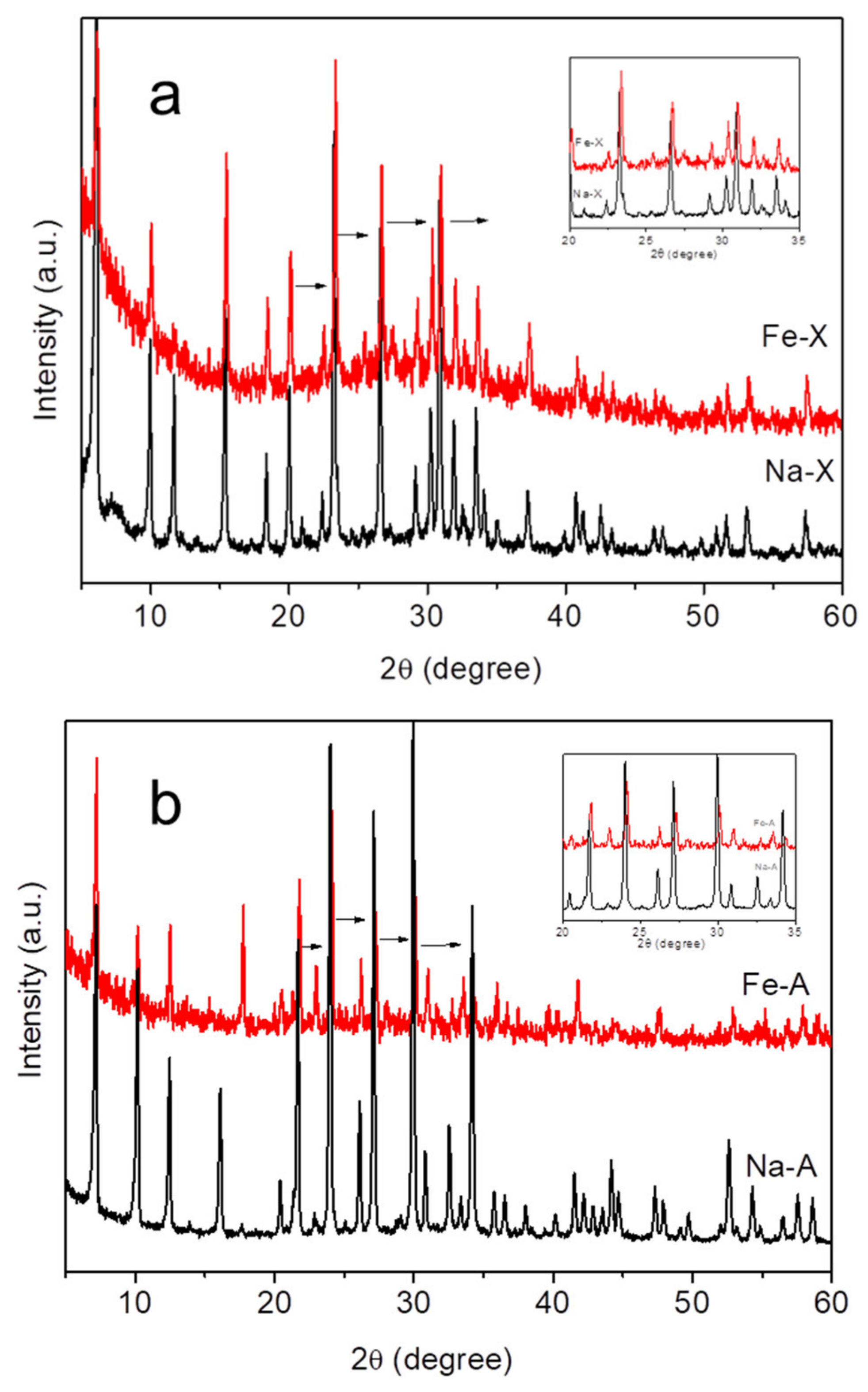
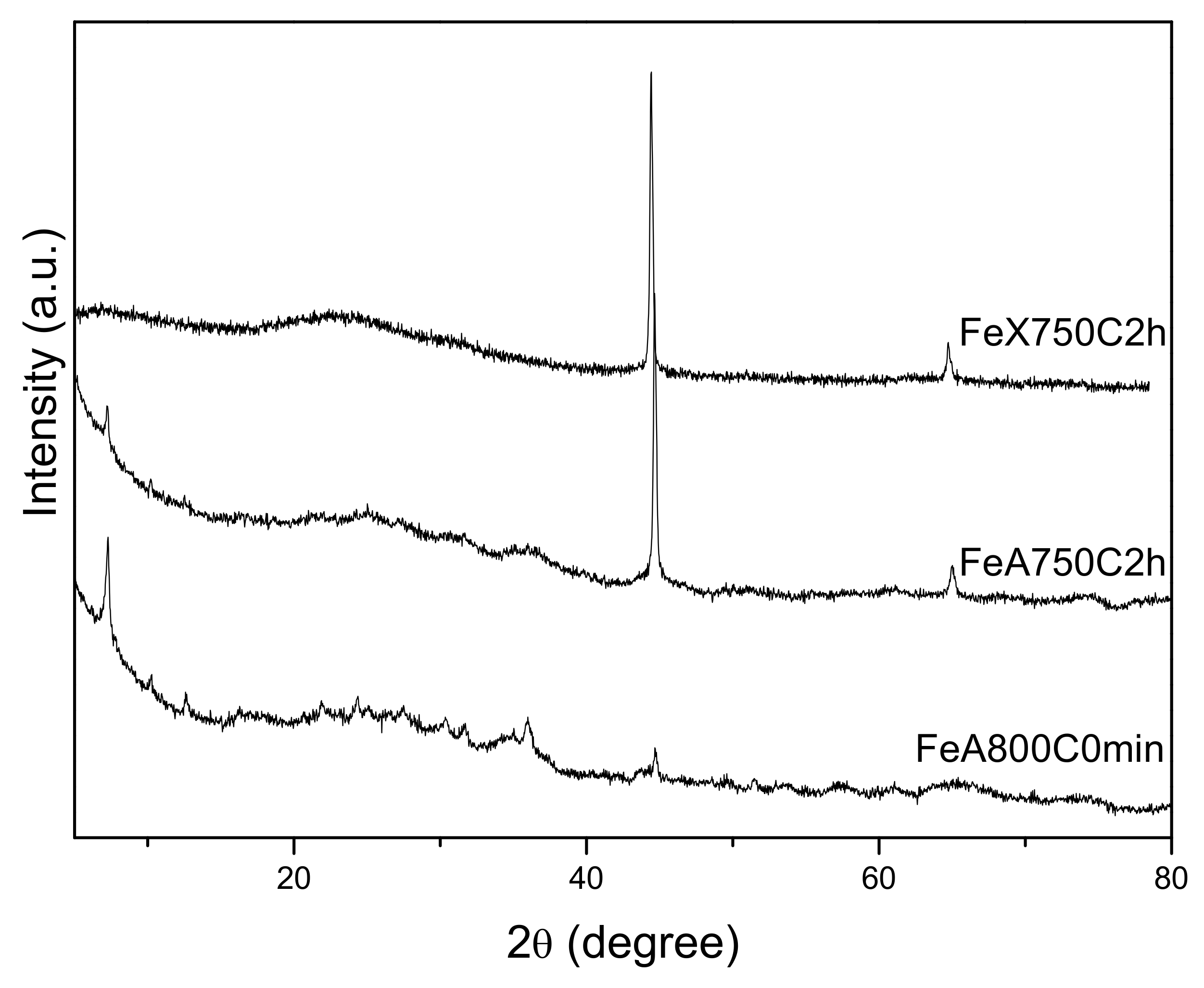
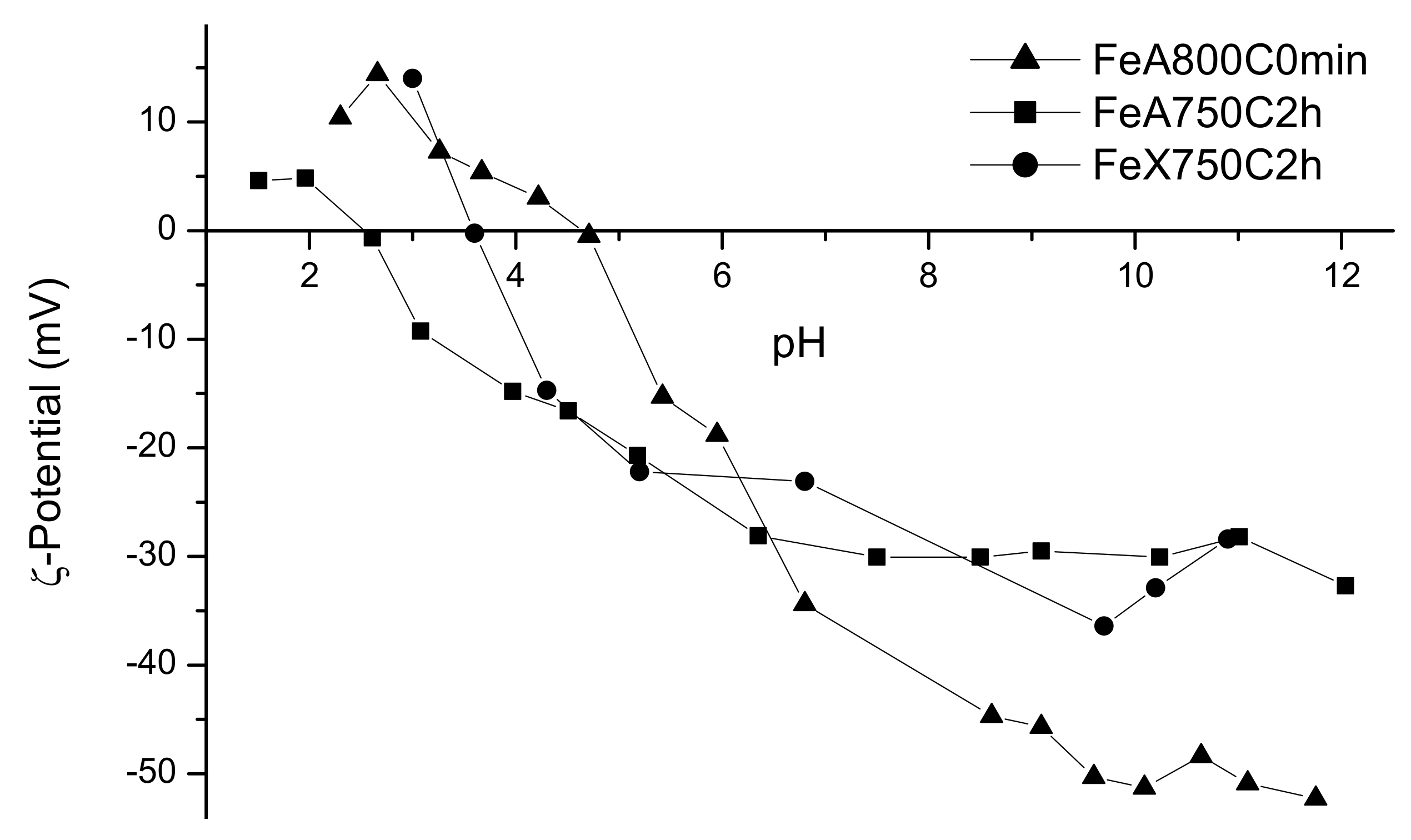
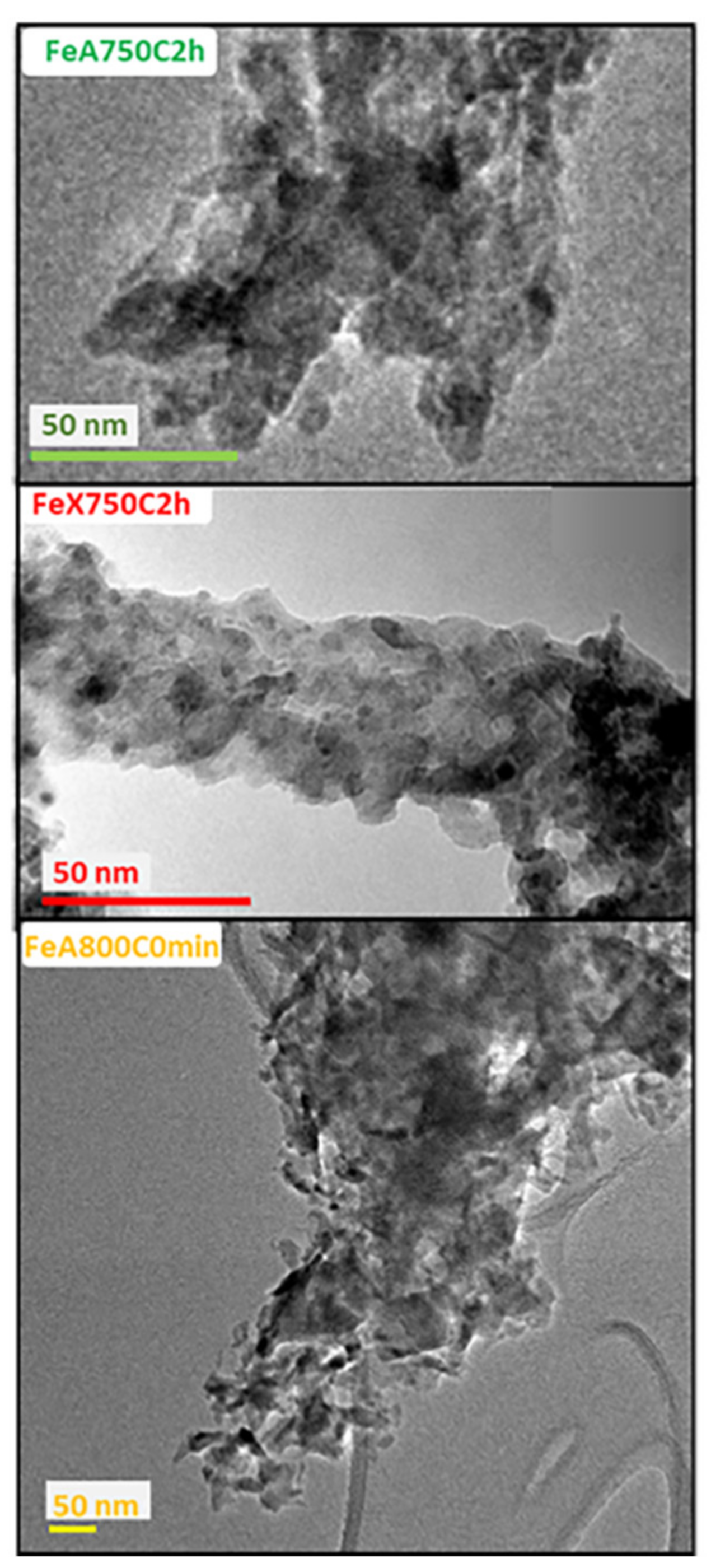
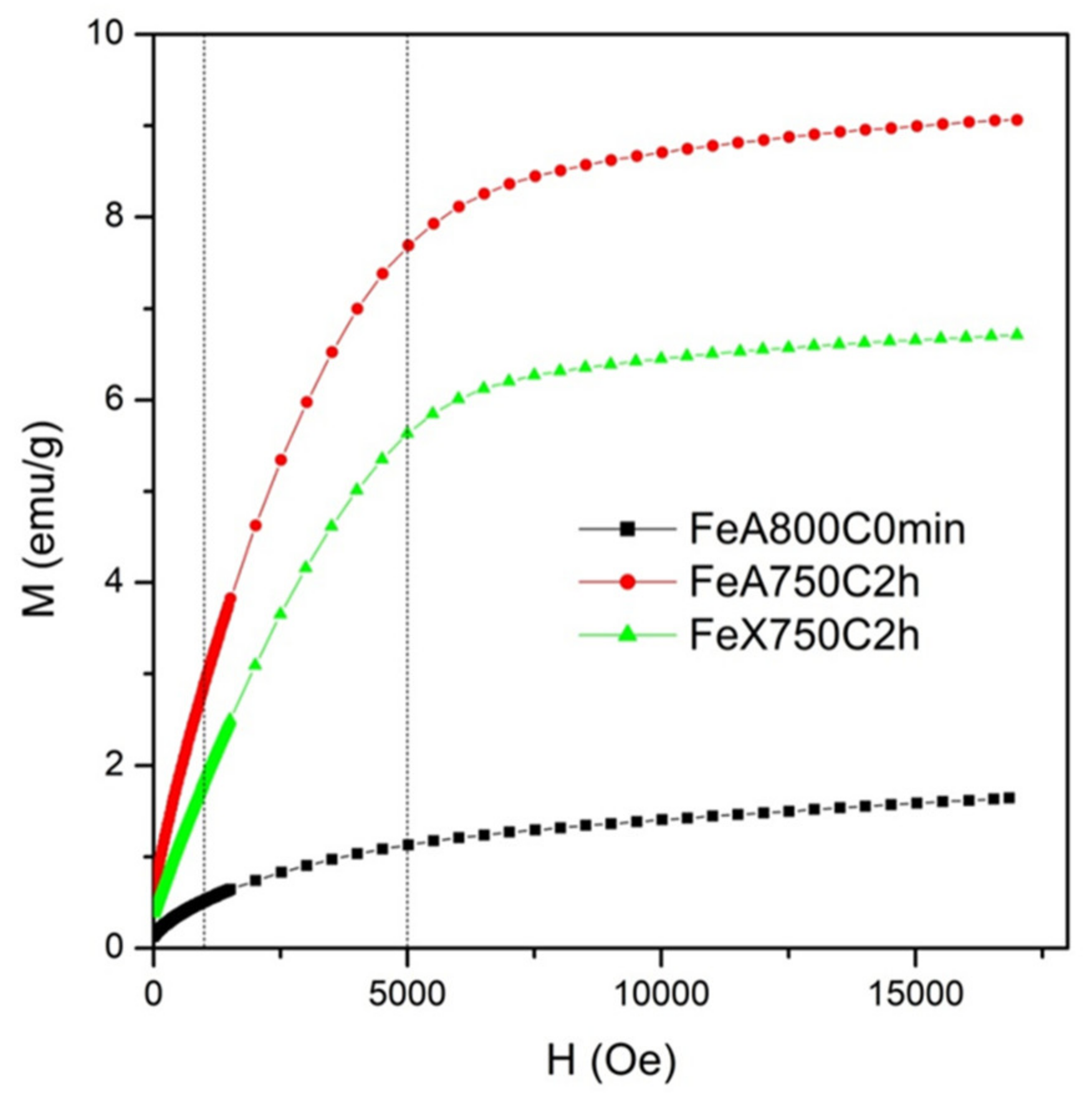
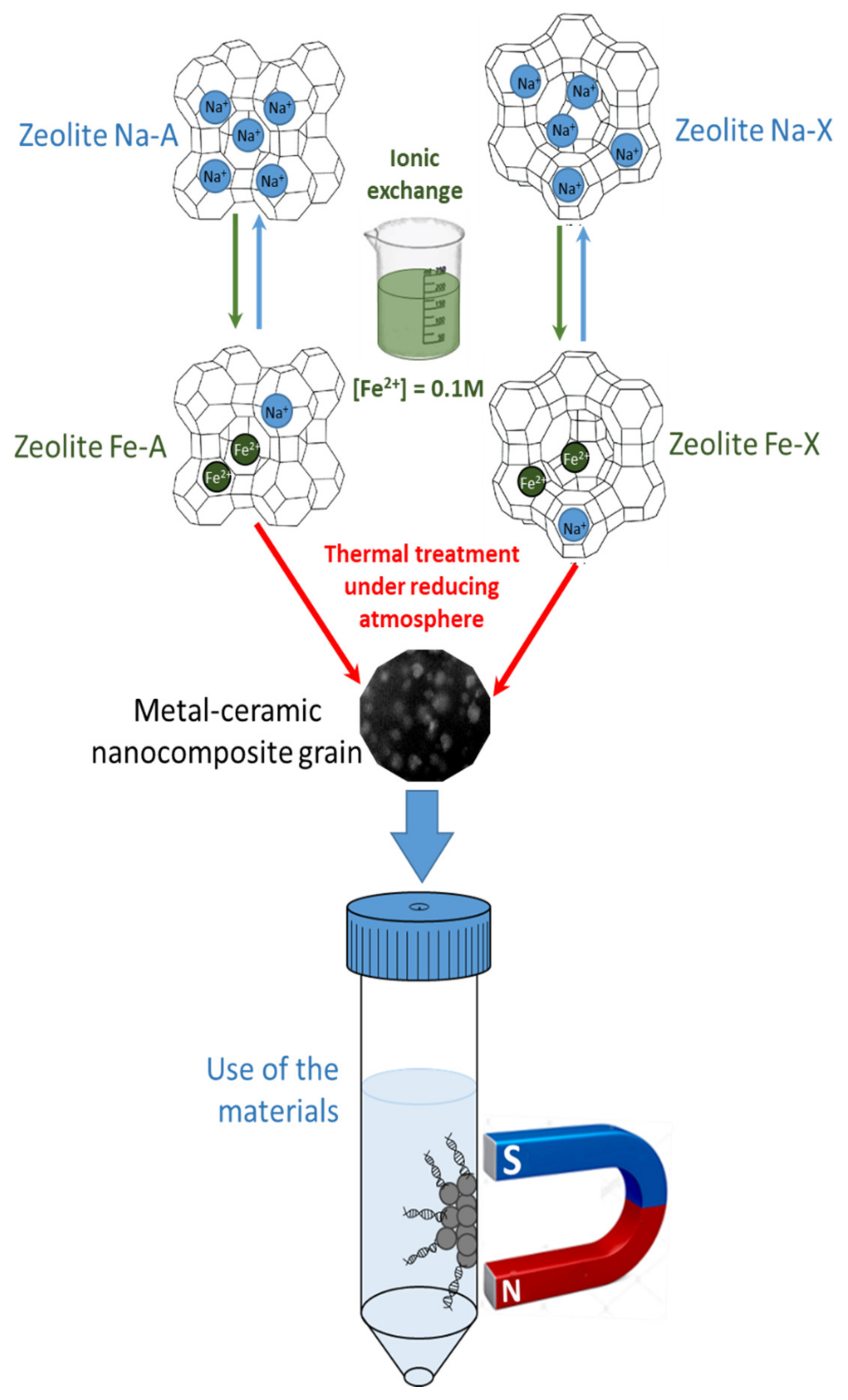
| Zeolite | Temperature | Length | Sample |
|---|---|---|---|
| Fe-A | 750 °C | 2 h | FeA750C2h |
| Fe-A | 800 °C | 0 min | FeA800C0min |
| Fe-X | 750 °C | 2 h | FeX750C2h |
| Magnetic Adsorbent | Parent Zeolite (wt.%) | Fe0 (wt.%) | Fe2SiO4 (wt.%) | Amorphous Phase (wt.%) | SBET (m2 g−1) | Vp (cm3 g−1) | Vmp (cm3 g−1) |
|---|---|---|---|---|---|---|---|
| FeA800C0min | 2.4 | 0.3 | 11.5 | 85.8 | 152 | 0.42 | 0.051 |
| FeA750C2h | 1.0 | 2.6 | 7.0 | 89.4 | 9.50 | 0.055 | 0.007 |
| FeX750C2h | - | 1.6 | - | 98.4 | 19.03 | 0.066 | 0.029 |
| SEPARATION 1 | |||||||||
| Biological Entity | Adsorbent | Protocol | Modality | Ct | |||||
| Gene target RNASE | FeA800C0min | 1 | manual | 30 | |||||
| Gene target RNASE | FeA750C2h | 1 | manual | 32 | |||||
| Gene target RNASE | Chemicell NP | 1 | manual | 25 | |||||
| SEPARATION 2 | |||||||||
| Biological Entity | Adsorbent | Protocol | Modality | Ct | |||||
| Gene target RNASE | FeA750C2h | 4 | manual | 24 | |||||
| Gene target RNASE | FeX750C2h | 4 | manual | 23.4 | |||||
| Gene target RNASE | Chemicell NP | 1 | manual | 24.7 | |||||
| SEPARATION 3 | |||||||||
| Biological Entity | Adsorbent | Protocol | Modality | Ct | |||||
| Gene target RNASE | FeA750C2h | 5 | manual | 23.5 | |||||
| Gene target RNASE | FeX750C2h | 5 | manual | 23 | |||||
| Gene target RNASE | Chemicell NP | 1 | manual | 24.7 | |||||
| SEPARATION 4 (repeated 3 times) | |||||||||
| Biological Entity | Adsorbent | Protocol | Modality | Ct | |||||
| Gene target factor V | FeA800C0min | 1 | manual | 26 | 27 | 28 | |||
| Gene target factor V | FeA750C2h | 1 | manual | 33 | 27.8 | 31.5 | |||
| Gene target factor V | Chemicell NP | 1 | manual | 26 | 26 | 27.4 | |||
| SEPARATION 5 | |||||||||
| Biological Entity | Adsorbent | Protocol | Modality | Ct | |||||
| Gene target factor V | FeA800C0min | 2 | manual | 27.7 | |||||
| Gene target factor V | Chemicell NP | 2 | manual | 26.7 | |||||
| SEPARATION 6 | |||||||||
| Biological Entity | Adsorbent | Protocol | Modality | Ct | |||||
| Gene target factor V | FeA800C0min | 3 | manual | 27 | |||||
| Gene target factor V | FeA750C2h | 3 | manual | 28 | |||||
| Gene target factor V | Chemicell NP | 3 | manual | 24.9 | |||||
| SEPARATION 7 (repeated 3 times, average value reported) | |||||||||
| Biological Entity | Adsorbent | Protocol | Modality | Ct | |||||
| Gene target factor V | FeA800C0min | 4 | manual | 25.6 | |||||
| Gene target factor V | FeA750C2h | 4 | manual | 25.4 | |||||
| Gene target factor V | Chemicell NP | 4 | manual | 26 | |||||
| SEPARATION 7bis (repeated 3 times, average value reported) | |||||||||
| Biological Entity | Adsorbent | Protocol | Modality | Ct | |||||
| Gene target factor V | FeA800C0min | 4 | manual | 23.6 | |||||
| Gene target factor V | FeA750C2h | 4 | manual | 24.7 | |||||
| Gene target factor V | Chemicell NP | 4 | manual | 24 | |||||
| SEPARATION 8 (repeated 3 times, average value reported) | |||||||||
| Biological Entity | Adsorbent | Protocol | Modality | Ct | |||||
| Gene target factor V | FeA800C0min | 5 | manual | 27.3 | |||||
| Gene target factor V | FeA750C2h | 5 | manual | 28.5 | |||||
| Gene target factor V | Chemicell NP | 5 | manual | 25.6 | |||||
| SEPARATION 8bis (repeated 3 times, average value reported) | |||||||||
| Biological Entity | Adsorbent | Protocol | Modality | Ct | |||||
| Gene target factor V | FeA800C0min | 5 | manual | 24.6 | |||||
| Gene target factor V | FeA750C2h | 5 | manual | 23.3 | |||||
| Gene target factor V | Chemicell NP | 5 | manual | 24 | |||||
| SEPARATION 9 (performed adding different amounts of blood) | |||||||||
| Biological Entity | Adsorbent | Protocol | Modality | Ct at Blood Volume (µL) | |||||
| 100.0 | 10.0 | 1.0 | 0.1 | ||||||
| Gene target factor V | FeA800C0min | 4 | manual | 25.7 | 28 | 30.8 | 34 | ||
| Gene target factor V | FeA750C2h | 4 | manual | 26 | 26.3 | 30 | 35 | ||
| Gene target factor V | Chemicell NP | 4 | manual | 24.1 | 28.4 | 32 | 35.7 | ||
| SEPARATION 10 (repeated 3 times, average value reported) | |||||||||
| Biological Entity | Adsorbent | Protocol | Modality | Ct | |||||
| Staphylococcus aureus | FeA800C0min | 4 | manual | 35 | |||||
| Staphylococcus aureus | FeA750C2h | 4 | manual | 33.4 | |||||
| Staphylococcus aureus | Chemicell NP | 4 | manual | 32.4 | |||||
| SEPARATION 10 bis (repeated 3 times, average value reported) | |||||||||
| Biological Entity | Adsorbent | Protocol | Modality | Ct | |||||
| Staphylococcus aureus | FeA800C0min | 4 | automated | 35.2 | |||||
| Staphylococcus aureus | FeA750C2h | 4 | automated | 33.3 | |||||
| Staphylococcus aureus | Chemicell NP | 4 | automated | 33.5 | |||||
© 2020 by the authors. Licensee MDPI, Basel, Switzerland. This article is an open access article distributed under the terms and conditions of the Creative Commons Attribution (CC BY) license (http://creativecommons.org/licenses/by/4.0/).
Share and Cite
Esposito, S.; Marocco, A.; Dell’Agli, G.; Bonelli, B.; Mannu, F.; Allia, P.; Tiberto, P.; Barrera, G.; Pansini, M. Separation of Biological Entities from Human Blood by Using Magnetic Nanocomposites Obtained from Zeolite Precursors. Molecules 2020, 25, 1803. https://doi.org/10.3390/molecules25081803
Esposito S, Marocco A, Dell’Agli G, Bonelli B, Mannu F, Allia P, Tiberto P, Barrera G, Pansini M. Separation of Biological Entities from Human Blood by Using Magnetic Nanocomposites Obtained from Zeolite Precursors. Molecules. 2020; 25(8):1803. https://doi.org/10.3390/molecules25081803
Chicago/Turabian StyleEsposito, Serena, Antonello Marocco, Gianfranco Dell’Agli, Barbara Bonelli, Franca Mannu, Paolo Allia, Paola Tiberto, Gabriele Barrera, and Michele Pansini. 2020. "Separation of Biological Entities from Human Blood by Using Magnetic Nanocomposites Obtained from Zeolite Precursors" Molecules 25, no. 8: 1803. https://doi.org/10.3390/molecules25081803
APA StyleEsposito, S., Marocco, A., Dell’Agli, G., Bonelli, B., Mannu, F., Allia, P., Tiberto, P., Barrera, G., & Pansini, M. (2020). Separation of Biological Entities from Human Blood by Using Magnetic Nanocomposites Obtained from Zeolite Precursors. Molecules, 25(8), 1803. https://doi.org/10.3390/molecules25081803










